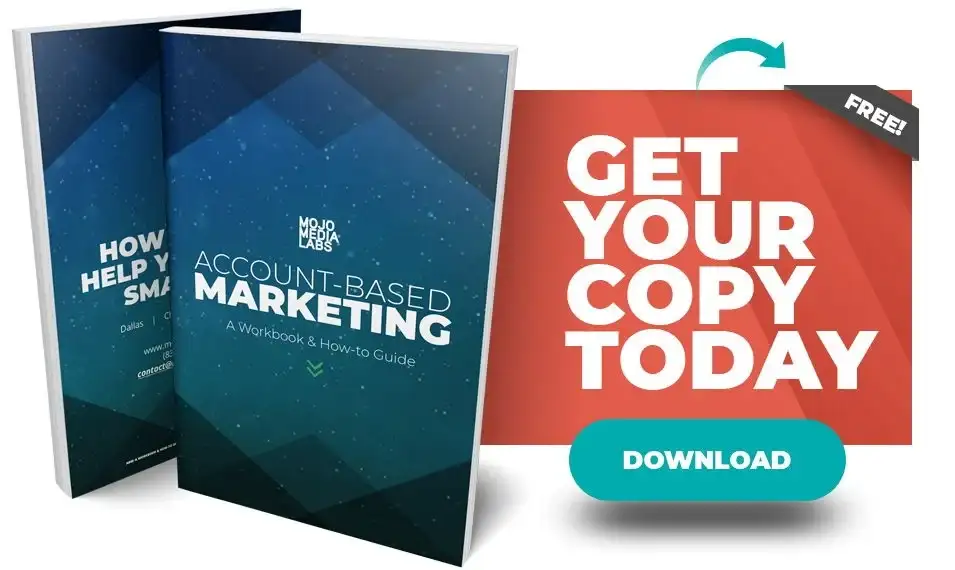The Ideal Customer Profile Framework
Targeting the right accounts is absolutely critical for success with account-based marketing (ABM). That's why the best ABM programs start by creating an Ideal Customer Profile (ICP). Without an ICP, ABM becomes nearly impossible.
This blog will cover:
What is an Ideal Customer Profile?
Identifying your Best-Fit Customers
Defining your Ideal Customer Profile
What is an Ideal Customer Profile?
Before diving into how to create an ICP, it's best to define our terms. Simply put, your ICP outlines qualities, both quantitative and qualitative, so you can more easily identify your best-fit potential customers in your target market. With an ICP in place, you have a framework you can use to create your target account list.
In most B2B markets, there is a high cost and high involvement from both the customer and the provider. That's why you can think about your ICP the same way you think about recruiting talent. When you look for talent to hire, you look for people that will increase your revenue, stay with your company for years to come, and will culturally fit your organization. In the same way, you want your ideal customers to increase your revenue, engage with your business for years to come, and will work well with your organization.
If you want a more in-depth look at the benefits of having an ICP, check out Why You Need an Ideal Customer Profile in Account-Based Marketing. With our terms defined, let's dive into the qualities you should look for when creating your ICP.
Identifying Your Best Customers
When you look to create your ICP, start by gathering a list of your best customers today. To gather this list of your best customers, there are a few conversations that need to take place.
- Speak to your finance department: One of the major benefits of ABM is a dramatic increase in ROI. The increase in ROI results from marketing specifically to companies that will result in higher profitability. When you go to your finance department, they should tell you which clients don't just bring in the most revenue but are the most profitable clients overall.
- Speak with your customer support: When you are well matched to the customer, they typically need less support. When they do need help, they are generally nice about it. What your support department can offer you is a list of clients that are pleasant to work with. They can also give you a list of clients that aren't as pleasant to work with.
- Speak to your sales team: For ABM to work effectively, marketing and sales must be aligned. Save this conversation for last because this conversation will become an ongoing one. Your sales team knows which customers were such a good fit that they sold themselves. You want to target customers where your product or service makes so much sense, they start to sell themselves. ‘
- Conduct Customer Interviews: After speaking with your team internally, you'll likely have a few customer accounts that keep coming up. Interview those customers to understand their perspective on why your company and theirs work well together.
Once you have these lists from these departments, start to identify some trends. A few questions you can ask yourself are:
- How many employees do our best customers have?
- What is the average annual revenue of our best customers?
- Who is typically the main point of contact?
- How many years have they been in business?
- What industry do they serve?
- Do they have established specific departments?
- What stage of business development are they in?
- What technology are they using?
- How long have they been partnering with us?
- Were they using a specific product or service before partnering with us?
- What is their company culture?
- How does their company culture mesh with ours?
- Do we align on mission and values?
- Where do they fall on the spectrum of risk vs innovation?
There are numerous additional questions you could ask that will pertain specifically to your business or industry. A SaaS company will likely have a few different questions than a manufacturing company. Just ensure the questions you ask are analyzing for potential trends.
Once you have a list of significant trends based on your existing customers, create a list of positive and negative attributes for potential customers. As you look to build out of your ICP framework, this list of customers will give you a great starting point.
Defining Your Ideal Customer Profile
Now that you have a list of trends based on your best customers, you want to start looking at the firmographic, and technographic makeup of these customers. By looking at their firmographics and technographic, you can create an ICP framework that will allow you to identify at a glance if a company is likely to be a good-fit customers long-term.
Firmographics
Firmographics are the physical attributes used to define organizations and are the first step in building your ICP. Most of the time, companies will use factors like company size, revenue, and years in the market to help define their ICP. These factors are a great start, but a highly effective ICP will have more specific qualities to help in your target account list creation. Here are just some of the firmographics you should consider:
- Company size or number of employees
- Revenue or revenue opportunity
- Average contract value
- Location
- Internal departments
- Tenure
- Budget
The list above identifies some of the most common qualities to look for, but your organization will likely have a few nuances you should consider. Again, look at the list of your best customers. Use the values that are important to you, and meet the demands of your organization. There are likely numerous similarities that will help you as you look to outline these qualities.
For example, An HR management firm will likely care more about employee count, or employees per manager more than revenue. A manufacturing supply firm may want to add in delivery site locations and look at the time to delivery because they've found customer satisfaction is higher if they can do the same or 2 days delivery.
Above all else, make sure the organization is aligned. If marketing start to deliver target accounts sales doesn't think are the best-fit customers, the entire process will break down. Everyone must be aligned and invested for ABM to work.
Technographics
This category defines the technical requirements for your ideal accounts. For example, HubSpot has found that their best-fit customers use over 8 integrations with their software. That means if a potential customer has numerous other pieces of technology that all have pre-existing HubSpot integrations, they are likely a good-fit customer. That also means if a potential customer is talking about adopting numerous pieces of technology, they are a potential good-fit customer.
Once again this must be unique to your industry and even preferences. Look at your best-fit customers and see what technology they all are currently using. The technology may not need to directly integrate with your product. For example, some technology companies attract customers that may align with your organization culturally. The technology they use can be a good indication of the kind of company they are internally.
Culture Qualities
Like mentioned earlier, you want to find customers that are a good fit for your organization culturally. Not everything that makes up a best-fit customer can come from the data.
Though we use our ICP to develop the target account list, use this portion of the ICP during your sales process to ensure that the target accounts are a good cultural fit.
When looking at your best-fit customers, ask the questions below to understand why those customers are a good culture fit for your company.
- What is their company culture and how does that mesh with yours?
- What drives them and how is this important to you?
- What general organizational behaviors does your organization work well with?
- Where do they fall on the spectrum of risk vs innovation?
You eventually need to find what works best for your organization. Though company culture may sound like something that can wait, a customer that doesn't mesh well with your culture will increase employee turn-over, decrease revenue, and will likely disengage your business.
A customer that does fit culturally causes you to focus on putting out fires instead of delivering results to happy customers.

Demographics and Buyer Personas
If you are familiar with the Inbound marketing methodology, you are likely familiar with a Buyer Persona. Inbound marketing focuses on building out your buyer personas to tailor content to their needs by answering their pain points with your company's solutions.
However, many inbound marketers somewhat overlook the ICP. That's the main difference between lead-based marketing and account-based marketing. In the B2B market, you are selling to more than just a single lead. You may have 5 leads that are all attached to a single agreement.
That's why when you start building your marketing message, B2B companies need to start with the ICP (firmographics) then identify the buyer persona (demographics). Now that you've identified what qualities are needed to examine organizations fit into your ICP, it is time to start looking at the individuals and the demographics that need your product.
Buyer Persona
Though your decision-maker might sit in the C-Suite, you may need to focus your awareness efforts on employees that are the end-users of your product. That's where your buyer personas come in.
Your buyer persona determines who your product or service resonates with by meeting their pain points. It is also an important part of targeting accounts in ABM, particularly at the engagement and expansion phase of the ABM funnel. It's about getting the right message in front of the right persona at the right time.
Identifying your buyer persona illuminates their pain points and how your organization's solutions meet and answer those pain points. You must match what sets you apart and what you offer to solve their pain.
The Roles in the Decision-Making Process
Every decision in the sales process is filled with different roles, and it is important to understand how they differ and how it will impact your content. These roles were defined by Sangram Vajre (@sangramvajre) in his book, Account-Based Marketing for Dummies:
- Stakeholders – These are your day-to-day users of the product. Why are they going to like your product? Why do they need your product?
- Champion – These are your power users. They don't just use your product, they love it. Apple's champions are the people that sit outside an Apple store to get the newest iPhone the second it comes out.
- Decision-maker – Organizations are using more decision-makers than ever when making purchase decisions. It is important to know if you are talking to decision-makers, and know how you influence them.
- Power Sponsor – These are likely your point of contact, they are the ones that bring your offer and present it to the organization's decision-makers. They need to be enabled to sell your product internally.
When you understand and identify these roles in an organization you'll have a better idea of how to reach them and start the sales cycle. In ABM, roles are not titles!
Archetypes
Companies and their employees each have their own archetypes, an individual is based on who they are, and a company is built through their culture and values. Archetypes give you a psychological basis for how your prospective contacts think, and how you need to solve their unique pain. There are many ways to identify archetypes, we like to use the three Ways from ROE powers ROI, the Return on Energy Methodology. Defining a good archetype is one of the most powerful content elements you can prepare for.

Using these archetypes, you can identify whether your prospect is focused on the vision of their company, the strategy, or the execution that is independent of their role in the decision-making process. Each has very important needs that vastly differ from one another. It is essential for an archetype to be rooted in their personality and skills, and is inherent in who they are.
Finding Your Accounts
Now that you've chosen your parameters it's time to find and score your accounts.
The first step is of course finding new accounts and identifying existing accounts (wherever they fall in your buyer's journey) that should be scored. There are many ways to do this:
- Sales targeted accounts – Utilize your sales team that has already identified important accounts, whether they are existing customers you would like to grow or prospects. As this is sourced by first-party data, it will have a high value to your ABM build-out.
- Utilize technology and research to find new accounts – Third-party data is expensive, yet can be very useful when building your list. You can put your ICP into a tool like SalesIntel and get a list of every company that fits your ICP. Then you can pull the contact information of the relevant members of the buying committee and start marketing to them.
- Partner or shared lists – Second-party data is incredibly valuable, and working with a partner that allows for sharing of lists back and forth can be mutually beneficial, especially when targeting highly relevant content through ABM.
Once you have a list of accounts it is time to see how well your accounts and prospective accounts fit into your ideal customer profile and identify where your ABM resources should be spent.
Scoring Your Accounts
Take the important firmographics and demographics you identified as part of your ICP and buyer personas and weigh each one based on importance to determine your account score.
You might be familiar with scoring your buyer personas, often called a lead score. A Lead score gives you insight into how well each contact fits into one of your buyer personas and how engaged they are. You can score these based on roles, responsibilities, pain points, and more.
Example:
- Revenue – This was chosen as the most important stat (won't always be the case), so it contributes more to account score than any other parameter. Accounts with <$100 million in revenue are worth 0 points, $101-250 million 3 points, $251-500 million 6 points, and $500+ 9 points.
- Location – Less important, but needs to be in the USA. For a Chicago-based company, it may look like, outside the USA 0 points, outside the Midwest 1 point, Midwest 3 points, Illinois 5 points.
- Culture – This may be more of a yes or no. It can be as simple as risk-averse is worth 0 points, but innovative is worth 5.
Now that you have scored your accounts you can begin grouping or putting your accounts into a tiered list. For example, Tier A is >$1B, Tier B is $500M - $1B and Tier C is <$500M, you can tier-three difference ACV (average contract values).
Your scored list of accounts will be matched against your ICP and will give you a blueprint for success with account-based marketing. These are your ideal clients that have been identified in a quantifiable and repeatable method, defined by your organization, services, and culture. Keep in mind that the account score is the sum of the individual buyer persona scores (lead scores) using the same company domain (account) and the account score itself. CRM software like HubSpot often has Account-scoring capabilities.
Get Started Today
Now understanding how to develop an ICP framework, the best thing you can do is schedule a meeting with your finance team to start identifying your best customers.
The temptation with something like developing an ICP is that it seems like it can wait for when you have a bit of time. It's not a "pressing project" like launching the newest campaign.
In reality, your ICP should serve as the foundational piece through which all of your marketing efforts tie back. The ICP identifies the customers you should market to. If you don't know who you're marketing to, it becomes near impossible to effectively execute marketing.
So start today. If you need additional assistance developing your ICP and getting started with ABM, feel free to schedule a call today.



